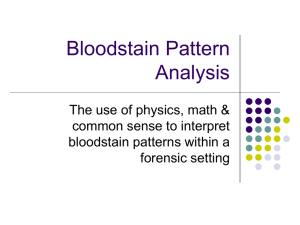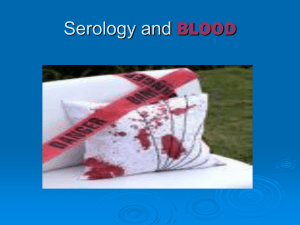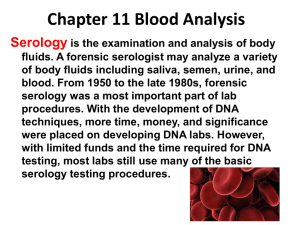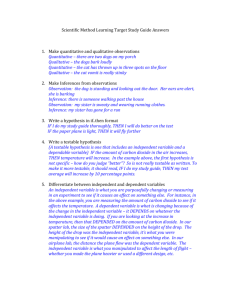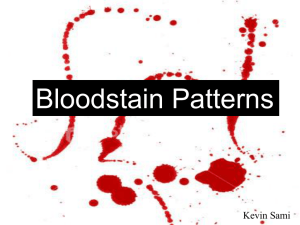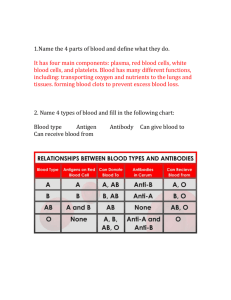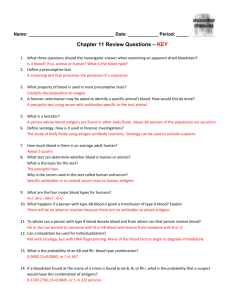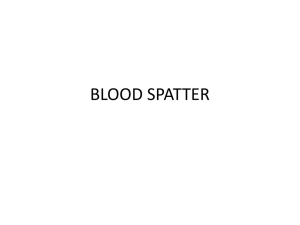Blood Spatter Notes - Syracuse High School
advertisement
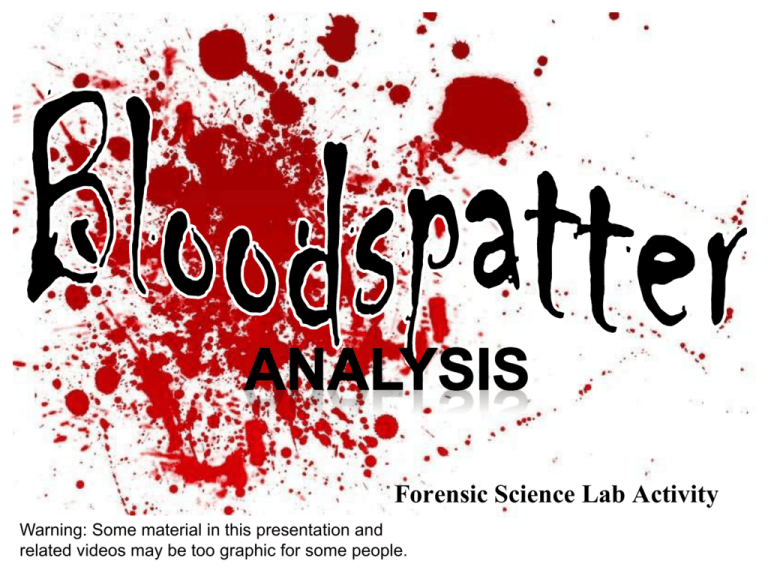
Forensic Science Lab Activity Warning: Some material in this presentation and related videos may be too graphic for some people. Blood Spatter Analysis Blood drops form different shapes and sizes Blood spatter analysis uses the shapes and sizes to reconstruct the crime scene. This is How Hollywood Interprets Blood Spatter Analysis: Formation of Blood Spatter: History • 1894 - Pitorowski wrote earliest reference to bloodstain pattern analysis. • 1939 - Balthazard was first to use physical interpretations of stains. • 1955 - Dr. Paul Kirkused bloodstain pattern interpretation as a defense witness in the Sam Shepherd case. • 1971 - Professor Herbert MacDonnell promoted bloodstain pattern interpretation as a tool for modern criminalistics. • 1983 – The International Association of Bloodstain Pattern Analysis was formed. What does the abbreviation BPA represent? Bloodstain Pattern Analysis What can an investigator learn from the analysis of a blood spatter? Type and velocity of weapon Number of blows Handedness of assailant (right or left-handed) Position and movements of the victim and assailant during and after the attack Which wounds were inflicted first Type of injuries How long ago the crime was committed Whether death was immediate or delayed How is blood evidence detected at a crime scene? Light Source Investigators will first examine the crime scene to look for areas that may contain blood. They may use a high-intensity light or UV lights to help them find traces of blood as well as other bodily fluids that are not visible under normal lighting conditions. How is blood evidence detected at a crime scene? Blood Reagent Tests These tests, referred to as presumptive tests, are used to detect blood at crime scenes based upon the properties of hemoglobin in the blood. Further tests at the crime lab must be done to verify that it is human blood. Examples: • Kastle-Meyer test. •HemaStix is a strip that has been coated with tetramethylbenzidine (TMB) and will produce a green or blue-green color with the presence of hemoglobin. The Kastle-Meyer test is • a presumptive blood test, first described in 1903, in which the chemical indicator phenolphthalein is used to detect the possible presence of hemoglobin. It relies on the peroxidase-like activity of hemoglobin in blood to catalyze the oxidation of phenolphthalin (the colorless reduced form of phenolphthalein) into phenolphthalein, which is visible as a bright pink color Kastle-Meyer Test Luminol / Blue Star This chemical is used by crime scene investigators to locate traces of blood, even if it has been cleaned or removed. Investigators spray a luminol solution is throughout the area under investigation and look for reactions with the iron present in blood, which causes a blue luminescence. One problem is that other substances also react, such as some metals, paints, cleaning products, and plant materials. Another problem is that the chemical reaction can destroy other evidence in the crime scene. Luminol Reaction Fluorescein This chemical is also capable of detecting latent or old blood, similar to luminol. It is ideal for fine stains or smears found throughout a crime scene. After the solution has been sprayed onto the substance or area suspected to contain blood, a UV light and goggles are used to detect any illuminated areas, which appear greenish-white if blood is present. It may also react to many of the same things as luminol (copper and bleach). Fluorescein Reaction in UV Light LCV or Leuco Crystal Violet, is one type of chemical process that is used for blood enhancement. Using this test helps to make the blood evidence more visible so it can be photographed and analyzed. Blood Pattern Analysis • • The use of physics and math to interpret bloodstain patterns within a forensic setting May show: 1. 2. 3. 4. 5. Activity at scene Number of blows Position of victim and assailant Whether death was immediate or delayed Weapon characteristics Bloodstain Pattern Analysis Terms • Spatter – Bloodstains created from the application of force to the area where the blood originated. • Origin/Source – The place from where the blood spatter came from or originated. • Angle of Impact – The angle at which a blood droplet strikes a surface. • Parent Drop – The droplet from which a satellite spatter originates. • Satellite Spatters – Small drops of blood that break of from the parent spatter when the blood droplet hits a surface. • Spines – The pointed edges of a stain that radiate out from the spatter; can help determine the direction from which the blood traveled. Satellite Spatters Spines Parent Drop Basic Principles • • A free falling drop of blood forms a sphere or ball. A spherical drop will break 1. When it strikes another object 2. When acted upon by some force Types of Bloodstain Patterns • Passive Bloodstains – Patterns created from the force of gravity. – Drop, series of drops, flow patterns, blood pools, etc. Types of Spatter Satellite Spatter = free falling drops of blood that fall onto a spatter pattern. These drips are usually much larger than impact spatter. However, blood dripping into blood can create a spatter. Types of Bloodstain Patterns • Projected Bloodstains – Patterns that occur when a force is applied to the source of the blood – Includes low, medium, or high impact spatters, cast-off, arterial spurting, expiratory blood blown out of the nose, mouth, or wound. Types of Spatter Gunshot Spatter = can result in a mist-like spatter that indicates a gunshot. Not all gunshots will result in misting. If misting is present, it is most likely a gunshot. Gunshot Spatter Gunshots result in back spatter (where bullet enters) and forward spatter (where bullet exits). Types of Spatter Beating and Stabbing Spatter = larger individual stains First blow usually doesn’t result in spatter since there is not yet any exposed blood. Arterial Gushing Arterial Spray (Gushing) Types of Spatter Castoff Pattern = Blood flung off of swinging object. Can reconstruct where assailant and victim were positioned. Cast-off Bloodstains Cast Off More Cast Off Types of Spatter Expirated Bloodstain Pattern = Blood can accumulate in lungs, sinuses, and airway. Forcibly exhaled. Can appear like beating or gunshot pattern. May be mixed with saliva or nasal secretions. Types of Bloodstain Patterns • Transfer or Contact Bloodstains – These patterns are created when a wet, bloody object comes in contact with a target surface; may be used to identify an object or body part. – A wipe pattern is created from an object moving through a bloodstain, while a swipe pattern is created from an object leaving a bloodstain. Other Patterns in Blood • Transfer patterns (gun, knife, hand, foot…) • Void patterns (indicating some object was removed or a person was hit by spatter) • Flow patterns (may indicate movement with change in flow) Void Drying Time • • Drying begins at periphery and proceeds inward Drying time is affected by – – – • Surface type Amount of blood Climatic conditions Skeletonization – – Partially dry stains leave a ring that outlines original spatter The drier the stain, the less skeletonization shown Clotting Time • Clotting time outside the body ranges from 3 – 15 minutes • Spattered clots indicate that time passed between the initial bleeding and later blows • Coughing of clotted blood may indicate post-injury survival of victim Alteration of bloodstain over time Blood dries and clots over time. Difficult to estimate the time the blood exited the body. Clotted smears can indicate time of movement. Blood Spatter > Distance Determining Distance Blood Falls Slower drop = larger diameter (size) Higher distance = larger diameter Due to air resistance, speed maxes out at distances above about 7 feet Spatter size is dependent upon velocity • Low velocity: – – – • Speed = about 5 ft/second. Usually 3 mm or greater in diameter. Indicates blood is dripping. Medium velocity: – – – • Speed = 6 – 25 ft/second. Between 1 - 3 mm in diameter. Usually indicates blunt trauma, sharp trauma or cast-off. High velocity: – – – – Speed = 100+ ft/second. Less than 1 mm in diameter. Indicating gunshot trauma, power tools, an object striking with extreme velocity (airplane prop) or an explosion. May be referred to as fly specks. Determining Distance Blood Falls • • Size depends on speed of blood drop. However, size of drop also depends on the volume of the drop. Volume depends on the object blood originated from (needle = small; bat = large). Effect of Surface Smooth surface = smooth sphere Rough surface may cause some splatter Determining Location of Blood Source • Direction of travel: – • tail will point in direction of travel. Angle of impact: – – Vertical drops are circular. Drop elongates as angle increases. Determining Direction of Blood Narrow end of a blood drop will point in the direction of travel. Determining Direction of Blood If more than one drop results from a spatter, the point of origin can be determined For each blood drop, a string can be guided back to the point of origin. Angle of Impact Angle of Impact “The tail tells the tale” • 90 degrees – • 60 degrees – • 30 degrees – • 10 degrees – Shapes of spatter are affected by angle of motion: Angle of Impact • Measure the width and the length (excluding tail) of the stain/spatter. • sine= width = 9mm length = 18mm (9 divided by 18 = 0.500) .500 = Angle of 30 Degrees Angle 0° sin .000 cos tan cot sec csc 1.000 .000 Undefined 1.000 Undefined . 26° .438 .899 .488 2.050 1.113 2.281 27° .454 .891 .510 1.963 1.122 2.203 28° .469 .883 .532 1.881 1.133 2.130 29° .485 .875 .554 1.804 1.143 2.063 30° .500 .866 .577 1.732 1.155 2.000 31° .515 .857 .601 1.664 1.167 1.942 32° .530 .848 .625 1.600 1.179 1.887 33° .545 .839 .649 1.540 1.192 1.836 34° .559 .829 .675 1.483 1.206 1.788 35° .574 .819 .700 1.428 1.221 1.743 36° .588 .809 .727 1.376 1.236 1.701 37° .602 .799 .754 1.327 1.252 1.662 Calculated point of origin • Closer for high velocity spatter or when stains originate closer to where the spatter occurred. Point and area of convergence • To determine the point/area of convergence an analyst has to determine the path the blood droplets travelled. The tangential flight path of individual droplets can be determined by using the angle of impact and the offset angle of the resulting bloodstain. • “Stringing” stains is a method of visualizing this. – For the purpose of the point of convergence, only the top view of the flight paths is required. This is a two-dimensional (2D) - not a 3D intersection. • The point of convergence is the intersection of two bloodstain paths, where the stains come from opposite sides of the impact pattern. String Convergence in a 2 Dimensional Plane Convergence • The area of convergence is the box formed by the intersection of several stains from opposite sides of the impact pattern. The Area of Origin • The area in 3dimensional space where the blood source was located at the time of the bloodletting incident. It includes the area of convergence with a third dimension on the z axis, which is perpendicular to the floor.
